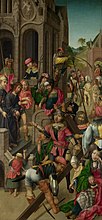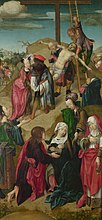Master of Delft

The Master of Delft (fl c. 1490–1520) was a Dutch painter of the final period of Early Netherlandish painting, whose name is unknown.[1] He may have been born around 1470. The notname was first used in 1913 by Max Jakob Friedländer, in describing the wings of a Triptych with the Virgin and Child with St Anne with the central panel by the Master of Frankfurt, which is now in Aachen. This has donor portraits of an identifiable family from Delft, that of the Burgomaster of Delft, Dirck Dircksz van Beest Heemskerck (1463–1545), with his wife and children.[2]
He can also be connected to Delft by the inclusion of the
As
Delft was apparently more notable as a centre for miniatures for
Rijksmuseum triptych

A triptych of the Virgin with saints and an unidentified
The outside of the wings, which would probably have been the everyday view of the work, kept closed except on special feasts or perhaps Sundays, show an Annunciation, mostly in grisaille except for the hair & other small areas.[17]
The central panel shows a hortus conclusus or small garden enclosed with a (very low) wall set in an urban scene with water and mountains in the distance. The Virgin sits near the front, with the Christ Child standing naked on her lap, holding her hair for support. There are several other figures, all female (or angelic) except for Saint Joseph at the back of the garden. At the front and sitting on the wall are two exotically dressed women; behind the Virgin a group of three angels are performing music, with bagpipes, a recorder, and the third singing from a musical score. Further back, and outside the garden, four women, none paying attention to those in the garden, seem to be ordinary inhabitants of the setting going about their lives.[18]
In the sky, a vision shows the Arma Christi, or Instruments of the Passion, in a tent whose hangings are pulled back by angels.[19] The scene is unusual in iconography, and has been explained by one scholar in an interpretation not yet generally accepted, and recognised but not agreed by Jan Piet Filedt Kok in his Rijksmuseum catalogue. According to this, rather than being saints who are hard to identify, the two women at the front of the gardens are sibyls, one of whom is showing the infant Christ his future.[20]
Other works
The outer sides of the van Beest triptych in Aachen whose wings he painted have a scene of
A triptych "possibly" by the master, in a private collection in Switzerland, has a central Adoration of the Magi, with a
Gallery
-
Christ Presented to the People: left wing, London
-
TheDeposition: right wing, London
-
Side wing from a Crucifixion triptych, Rijksmuseum Twenthe, "workshop of the Master of Delft".[27]
-
Virgin with the vision of Bernard of Clairvaux, c. 1495, Museum Catharijneconvent.
-
Workshop or follower, Christ Carrying the Cross, Louvre
-
The Deposition of Christ
See also
Notes
- ^ NG
- ^ Filedt Kok
- ^ Liedke, 30
- ^ NG; Filedt Kok (quoted)
- ^ NG
- ^ Liedke, 30
- ^ National Gallery, biography
- ^ Filedt Kok
- ^ Liedke, 29
- ^ Liedke, 28
- ^ Liedke, 30
- ^ Liedke, 28–29
- ^ Liedke, 31
- ^ Museum Catharijneconvent page
- ^ Filedt Kok
- ^ Ringbom, 181
- ^ Filedt Kok
- ^ Filedt Kok
- ^ Filedt Kok
- ^ Ringbom, 183–185
- ^ RKD page
- ^ Filedt Kok; RKD page
- ^ pop.culture.gouv.fr page; not on RKD
- ^ RKD page
- ^ RKD page
- ^ RKD artist page
- ^ Rijksmuseum Twenthe page
References
- ISBN 9780300077018
- Filedt Kok, J.P., "Master of Delft, Triptych with the Virgin and Child and saints (centre panel), the Donor with St Martin (inner left wing), the Donor’s wife with St Cunera (inner right wing) and the Annunciation (outer wings), c. 1500 – c. 1510", in J.P. Filedt Kok (ed.), Early Netherlandish Paintings, online coll. cat. Amsterdam 2010: hdl.handle.net/10934/RM0001.COLLECT.9539 (accessed 25 December 2020), online
- Liedtke, Walter, Walter Liedtke, Michiel C. Plomp and Axel Ruger, Vermeer and The Delft School, The Metropolitan Museum of Art, New York, 2001
- NG": "Triptych: Scenes from the Passion of Christ" ("in depth" tab)
- Ringbom, Sixten (1989). "Vision and Conversation in Early Netherlandish Painting: The Delft Master's "Holy Family", Simiolus: Netherlands Quarterly for the History of Art, 19(3), 181–190. doi:10.2307/3780718, JSTOR
External links
![]() Media related to Master of Delft at Wikimedia Commons
Media related to Master of Delft at Wikimedia Commons



![Side wing from a Crucifixion triptych, Rijksmuseum Twenthe, "workshop of the Master of Delft".[27]](http://upload.wikimedia.org/wikipedia/commons/thumb/9/90/Meester_van_Delft_-_De_kruisdraging_van_Christus_-_0041_-_Rijksmuseum_Twenthe.jpg/83px-Meester_van_Delft_-_De_kruisdraging_van_Christus_-_0041_-_Rijksmuseum_Twenthe.jpg)


